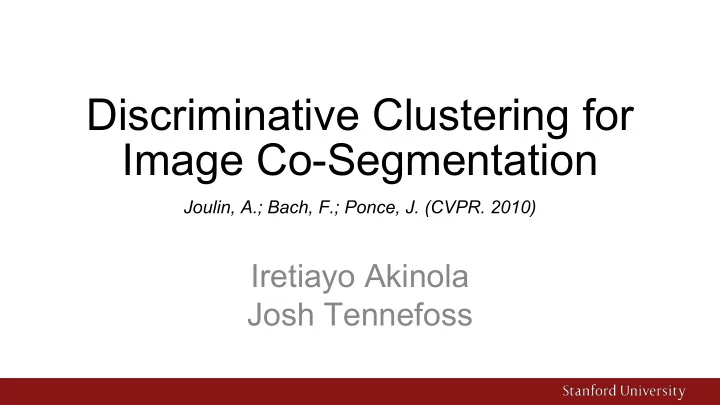

Discriminative Clustering for Image Co-Segmentation Joulin, A.; Bach, F.; Ponce, J. (CVPR. 2010) Iretiayo Akinola Josh Tennefoss
Outline Why Co-segmentation? ● Previous Work ● Problem Formulation ● Experimental Results ● Discussion: How do we improve? ●
Why Co-segmentation? Segmentation ( Regions & Boundaries ) Foreground- background (2-regions) ● Unsupervised Segmentation is Hard! Interactive segmentation ● Co-segmentation ●
Why Co-segmentation? Unsupervised Segmentation is Hard! Interactive segmentation (Bounding box, Intelligent scissors, ● region seeds)
Why Co-segmentation? Unsupervised Segmentation is Hard! Interactive segmentation ● Co-segmentation (with object names tagged) ●
Previous Work: Rother et al. 2006 "Cosegmentation of Image Pairs by Histogram Matching - Incorporating a Global Constraint into MRFs" A generative model for cosegmentation that minimizes energy function: E 1 (x): encodes spatial coherency E 2 (x): penalizes differences from fg/bg models Co-segmentation now formulated as optimization problem ● graph-cut technique applied
Previous Work: Hochbaum & Singh, 2009 An efficient algorithm for Co-segmentation Combines object recognition and image segmentation; pick out objects and their segmentations (detects multiple segments) Similar set-up with an energy function: E 1 (x): an MRF term encoding spatial coherency and E 2 (x): maximizes the similarity between similar regions . polynomial time optimization algorithm
Common Ideas ● Image data share common material ● Similar pixels in different images should be assigned to the same class ● Different regions should have different generative models ● Energy function that combines these two ideas ● Optimization techniques for minimizing energy function
Contribution of this paper More robust co-segmentation algorithm that performs well on a larger range of foreground appearances.
Overview and Goals ● Goal : Co-segment images better than segmenting a single image alone ● Output : Y is in {-1, 1} for all pixels, corresponding to foreground or background ● Idea : If a pixel is foreground in one image, and there is a similar pixel (spectrally, spatially, and in feature space) in another image, then it is more likely to be foreground in that image. Similarly for background. ● Benefit : We have lots of tagged images (e.g. ImageNet)
Overview of Approach First step is over-segmentation (derive super-pixels) so the algorithm can fit within reasonable memory and compute requirements. To go from over-segmentation to the real-valued mask: 1. Account for spatial relationships within a single image (maximize appearance consistency) 2. Extract features for each pixel (SIFT, gabor, color histogram) 3. Adjust for the two images having similar foreground objects (discriminate the common foreground pixels from other regions)
Formulation – Spatial Agreement • Create a block diagonal similarity matrix, W, based on colors, c, and positions, p, on close pixels
Formulation – Spatial Agreement Define the normalized Laplacian as ● If we output second smallest ● eigenvector, we would So include in objective ●
Formulation - Discriminative Agreement Create an SPD similarity matrix on all pixels using their feature ● space and their (currently unknown) labels. k features extracted ● l & m are the pixels, x d is the feature ●
Formulation - Discriminative Agreement ● Phi is chosen based on the book Kernel Methods for Pattern Analysis, Share-Taylor and Christiann, 2004 ● Fit a ML model to K, to best fit an affine classifier, f and b, to fit y based based on K
Formulation - Discriminative Agreement Using DIFFRAC (Bach & Harchaoui 2007), for each (prediction) y, we can calculate overall class inseparability as g(y) :
Formulation - Combining Spatial and Discriminative Discriminative agreement between all pixels Spatial agreement within a single image
Restriction on Solution • The trivial solution (where all pixels are of the same class) is optimal for A without an additional constraint. • Add a constraint, for each image i, to force the percent of pixels from each class in each image to be bounded by λ 0 and λ 1 they use 5% and 95%, respectively.
Solving: convex objective Mixed-integer problem is not convex For convexity, change from restricting y to be an integer to being in an elliptope But rank(Y) = 1 is not convex ☹
Solving: low rank solution • Journee Et Al (2008) have published a lower rank semidefinite problem solver. But, this solver cannot handle inequality constraints…. • So for each constraint, h, add a twice differentiable penalty of • With some (excluded) tricks, we can find relatively low rank solutions over Y.
Getting y • Project the solution Y onto unit rank PD matrices by taking the eigenvector of the largest eigenvalue, giving
Getting y ● Then round each element of y to 1 or -1 relative to 0. ● Hand select if 1 is foreground or background, and -1 is the other one
Experimental Results ● Low-variability datasets very similar foreground, fewer images ● High-variability datasets higher variation in foreground appearance, more images to co- segment metric: misclassification error (% of well-classified pixels in each image.)
Experimental Results Low Inter-class variation
Results Summary Low Inter-class variation
Experimental Results Low Inter-class variation
Experimental Results High Inter-class variation
Experimental Results High Inter-class variation
Results Summary High Inter-class variation
Why Co-segmentation? multi-image vs single-image segmentation (a) Original Image (c) our algorithm on a single image (b) multiscale normalized cut (d) our algorithm on 30 images
Discussion: How might we improve this? ● Accuracy Holistic image similarity metric before running this method, i.e. weight the K matrix according to the image from which the pixel is taken ● Accuracy Different features for similarities, e.g. autoencoder or CNN-based features
Discussion: How might we improve this? ● Border resolution Rerun seeded algorithm without superpixels on the fg/bg boundary ● Leverage other technologies Output a bounding box or seeds → GrabCut or similar ● What do you think???
Recommend
More recommend